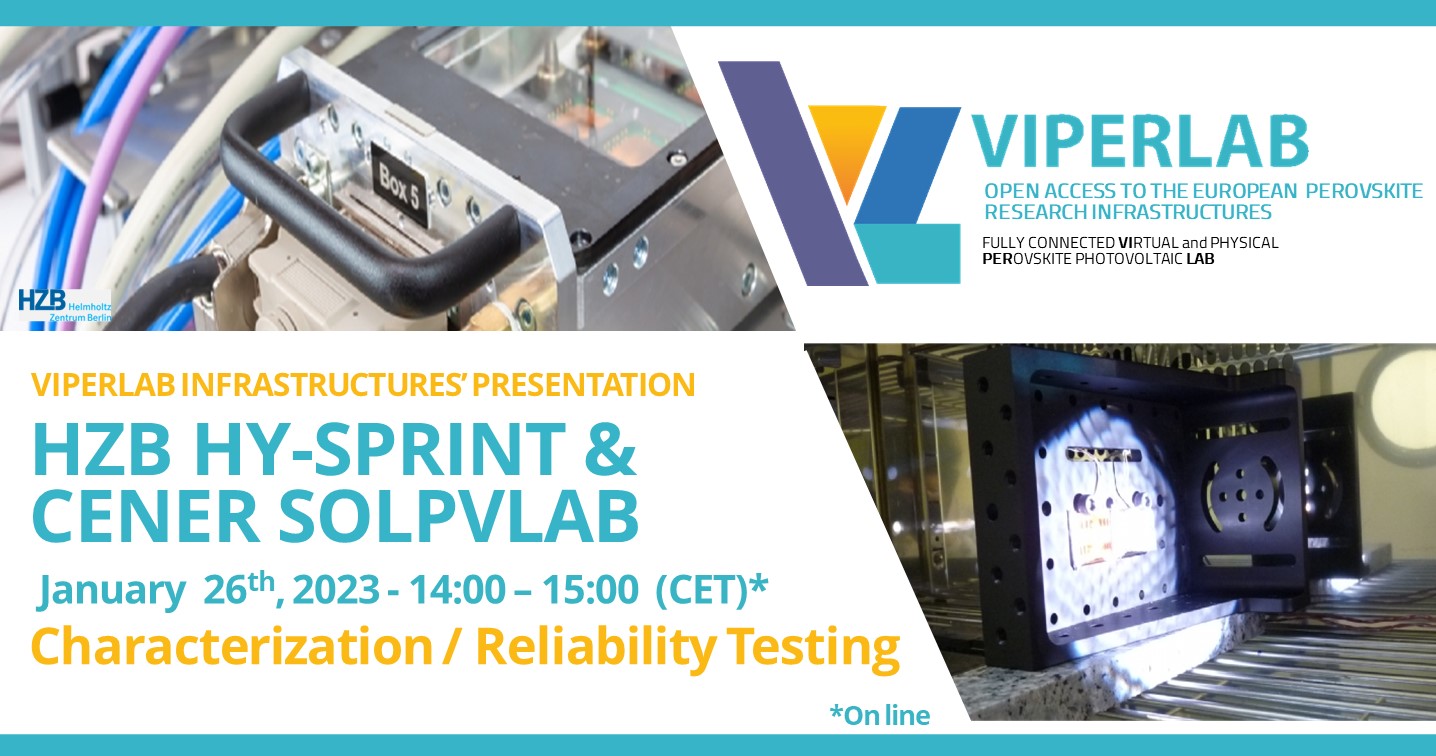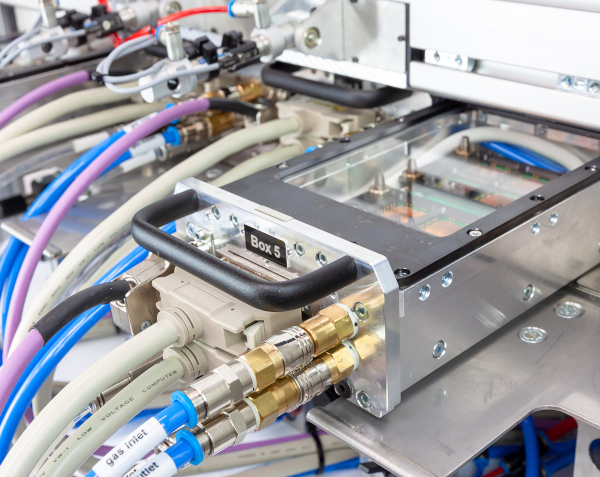HZB HySPRINT & CENER-SOLPVLAB Infrastructures' presentation

To participate click the button at the bottom of the page
VIPERLAB is an H2020 EU-funded project bringing a network of Europe-based scientists and research organizations in Perovskite PV. The mission of VIPERLAB is to facilitate faster and reliable technology evaluation cycles to enable a swift market entry for Perovskite-based PV products and hence a more wide-spread utilization of renewable energy conversion technology.
H2020 VIPERLAB Project offers free access to the state-of-the-art perovskite EU infrastructures that cover the whole innovation/value chain from material preparation to characterization of perovskite devices and modules.
Perovskite solar cells may provide efficient, low-cost energy production. On other hand the stability of perovskite devices must be addressed to achieve commercialisation.
The key factors influencing the stability of the devices are the exposure to oxygen and moisture, UV light, solution processing and thermal effects. Encapsulation and standard testing protocols are required to check and improve stability.
On January 26th, 2023 14:00-15:00 (CET) we present two very interesting VIPERLAB Research Infrastructures offer state of the art equipment for the Perovskite Stability testing of materials and device
| HZB - HySprint – Stability Lab | |||||||
 |
The Helmholtz Innovation Lab HySPRINT is equipped with two very relevant equipment for stability testing The first offers opportunities for long term measurements and ageing of a very high number of single-junction PSC and monolithic tandem solar cells (e.g. PSK/Silicon and PSK/CIGS) under realistic conditions, being operated at their Maximum Power Point (MPP). This allow high throughput as well as a high level of statistical confidence. The High-Throughput Aging-System is equipped with electronics that allow the infrastructure to MPP-track more than 380 solar cells in parallel. The second instrument, is a Tandem Ageing-System, equipped with electronics that allow us to track 20 tandem solar cells in parallel. As the performance of monolithic tandem solar cells is strongly dependent on the utilized spectrum, an array of 193 LEDs with two different peak wavelengths in red and blue light was engineered. The 470 nm and 940 nm centre emission wavelengths are absorbed in the top- and bottom cell, respectively. Both intensities can be tuned independently to adjust the desired photocurrents of the subcells, to artificially induce a mismatch between the subcells in a controlled way. The cells are measured in ambient conditions with a controlled temperature of 25°C Photo: Contacted Probe-box @ HySprint (© HZB) |
||||||
| Infrastructure video presentation here | |||||||
|
CENER SolPVlab is an EC Accredited PV Module testing Lab offers state of the art equipment for the development and application of specific protocols to characterize photovoltaic devices based on different non-concentrating/concentrating PV technologies organic and perovskite materials. The infrastructure offer both custom-made stabilization, and aging and reliability testing based on approved standards such as IEC standards for all PV technologies: IEC-61215-1(all subparts), IEC61215-2, IEC-61730-(1&2) , IEC-62108, IECTS60804-1 (PID) and IEC TS 60904-13 (EL). Taking advantage of the experience gained through their application in many products of different technologies, degradation protocols based on accelerating aging tests ISOS (ISOS-D, ISOS-O, ISOS-L, ISOS-T and ISOS-LT) from Basic (level 1) to Advanced (level 3) combining humidity – temperature and radiation in climatic chambers and outdoor test can be implemented in order to study the degradation factors for emerging PV technologies Photo: Stabilization test of a Perovskite Solar cells@ CENER |
|
||||||
| Infrastructure video presentation here | |||||||
Informations
|
|
Videos/slides are now available. Click on the links below in the agenda* |
|
| Contacts: to get more information about this event | |||
| |
Dr. Natalia Maticiuc | HZB | |
| |
Dr. Francesco Roca | ENEA | |
| For any technical need | |||
| |
Viperlab C&D Team | ||
*Note that to access to the videos/slides you must first install Adobe Connect App, if you haven't already. Consult the technical section for more information
Agenda
| Time | Title | Speakers |
|---|---|---|
| 14:00 - 14:10 | Introduction |

Natalia MATICIUC
Technical Manager - WP11 Leader
|
| 14:10 - 14:30 | HZB – HySPRINT – Stability Lab |

Hans KÖBLER
Instrument scientist
|
| 14:30 -14:50 | CENER-SolPVlab - Accredited PV Module Testing Lab |

Ana Belén CUELI

Javier DIAZ BERRADE
|
| 14:50 - 15:00 | Questions & Answers | |







